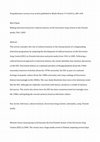Papers by Mari Pajala
Critical Studies in Media …, Jan 1, 2010

VIEW: Journal of European Television History & Culture 3:5 (2014)
Research on Finnish television history has so far emphasized Western influences. However, the Fin... more Research on Finnish television history has so far emphasized Western influences. However, the Finnish television environment was also shaped in many ways by contacts with socialist television cultures. This article analyses the first volume of the television magazine Katso to trace the various transnational relations, which shaped the early Finnish television environment and to discuss the cultural meanings of socialist television in this environment. Nearly every issue of Katso in 1960 discusses television in a transnational context. Transnational themes fall into four categories: (1) learning about television in other countries; (2) the Eurovision and Nordvision networks; (3) watching television across national borders (Swedish and Tallinn television but also television across surprising distances); and (4) visions of world television. Katso’s understanding of television emphasizes the literal meaning of television: to see far. The magazine sets no clear limits to what television could do in terms of overcoming physical distance and ideological borders. The magazine avoids overt politics in discussing television from both the West and the East and represents television broadcasting from Tallinn as a potential source of popular television for Finnish audiences.
Alexander Badenoch, Andreas Fickers & Christian Henrich-Franke (eds.) Airy Curtains in the European Ether: Broadcasting and the Cold War. Baden-Baden: Nomos-Verlag, 2013, pp. 215–239.
VIEW: Journal of European Television History and Culture 1:2 (2013)
The Eurovision Song Contest (ESC) offers a unique viewpoint to the ways Europe has been imagined ... more The Eurovision Song Contest (ESC) offers a unique viewpoint to the ways Europe has been imagined on television from the 1950s to the present. This paper looks at the use of a key visual symbol for Europe, the European map, to outline the history of the ESC’s representation of Europe. Whilst the European map was rarely used during the first decades of the ESC, it became a central visual element of the show in the 1990s, a period of great political change in Europe. Since then, the ESC maps have pictured an ever widening image of Europe, gradually moving towards a dynamic, moving image of Europe and finally, dispensing with a coherent map of Europe altogether.
Keywords
Eurovision Song Contest; European Broadcasting Union; Europe; maps; television history
Critical Studies in Television: scholarly studies in Small Screen Fictions 5:2 (2010), 133-145., Jan 1, 2010
European public service broadcasters have begun to make parts of their programme archives availab... more European public service broadcasters have begun to make parts of their programme archives available as online television archives. This article discusses the implications of this move for the relationship between television and memory. Contributing to discussions on mediated memory, it argues that online archives increasingly associate television as a medium with history and memory. Moreover, the article considers how cultural memory works in an online television archive. The article is based on an analysis of the Finnish public service broadcaster YLE's online archive Elävä arkisto ("The living archive"), focusing particularly on its section on television drama. Elävä arkisto is discusses in relation to the online archives of other European public service broadcasters.

Media History 17:4 (2011), pp. 405-418., Jan 1, 2011
This article considers the role of cultural memory in the interpretation of a long-standing telev... more This article considers the role of cultural memory in the interpretation of a long-standing television programme by analysing the development of cultural memory on the Eurovision Song Contest (ESC) on Finnish television and print media from 1961 to 2005. Following a cultural historical approach to television history, the article identifies four memory discourses on the ESC: Eurovision history as a national narrative of disappointment (from the 1960s onwards); histories of decline (from the 1970s onwards); the ESC as part of a national heritage of popular culture (from the 1980s onwards); and camp readings of Eurovision history (increasingly in the 2000s). The case study illustrates how even a live television event like the ESC, although not explicitly concerned with history, produces a wealth of memory discourses. The article also shows how the ESC has been commemorated increasingly since the 1980s, anticipating the current memory boom in television culture.

Critical Studies in Media Communication 27:2 (2010), 174-192., Jan 1, 2010
In 2006–2007, the romantic affair between Finnish Prime Minister Matti Vanhanen and white-collar ... more In 2006–2007, the romantic affair between Finnish Prime Minister Matti Vanhanen and white-collar worker Susan Kuronen received unprecedented attention in the national media. Analyzing the coverage of the affair and its aftermath in Finnish evening papers through Sara Ahmed's notion of affective circulation, the present article investigates the drawing of public and private boundaries through the public reviling of Kuronen for revealing intimate details concerning Vanhanen's private life. As the couple's relationship unraveled, the evening papers began fashioning class differences between the parties both previously characterized as “ordinary” and middle-class, labeling Kuronen as common and trashy. Addressing the dynamics of class and gender at play, the article shows that although Kuronen was accused of continuously revealing her private life, she actually gave few interviews herself. Rather, the popular press reused the same comments and quotes extensively in an intertextual process of circulation through which Kuronen was crafted into a highly affective media figure and an object of considerable public dismay. In addition to exploring the intertextual working practices of the popular media, the article investigates the effects of the circulation of affect from evening papers to online discussion forums as underpinned by social hierarchies, the uses of privacy as a politician's media strategy as well as the risks that this involves.
Journalismikritiikin vuosikirja 2013, pp. 107–120.
Articles and essays by Mari Pajala











Uploads
Papers by Mari Pajala
Keywords
Eurovision Song Contest; European Broadcasting Union; Europe; maps; television history
Articles and essays by Mari Pajala
Keywords
Eurovision Song Contest; European Broadcasting Union; Europe; maps; television history